Analysis of Business Law: Tort, Negligence, and Misrepresentation
VerifiedAdded on 2020/06/04
|9
|2788
|66
Report
AI Summary
This report provides an overview of key concepts in business law, specifically focusing on the tort of negligence and misrepresentation. It begins with an introduction to these legal principles and their significance in the context of business operations. The report delves into the components of the tort of negligence, including parties involved, intentions, legal obligations, and relevant laws. It further explores the elements of duty of care, breach of duty, damages, and remoteness within negligence claims. The discussion then shifts to misrepresentation, examining the Misrepresentation Act 1967 and its implications for consumer protection. The report outlines remedies available to victims of misrepresentation, such as damages and contract unwinding, and explores the requirements for proving a misrepresentation claim. Additionally, the report touches on exemption and limitation clauses, and the consequences of unfair business practices. The report also touches on the importance of Australian law and its basis in English common law. Finally, the report discusses the importance of legal rules and regulations and their impact on individuals and organizations. Throughout, real-time cases and legal provisions are used to illustrate the concepts. This analysis aims to provide a comprehensive understanding of these legal concepts and their practical implications in business settings.
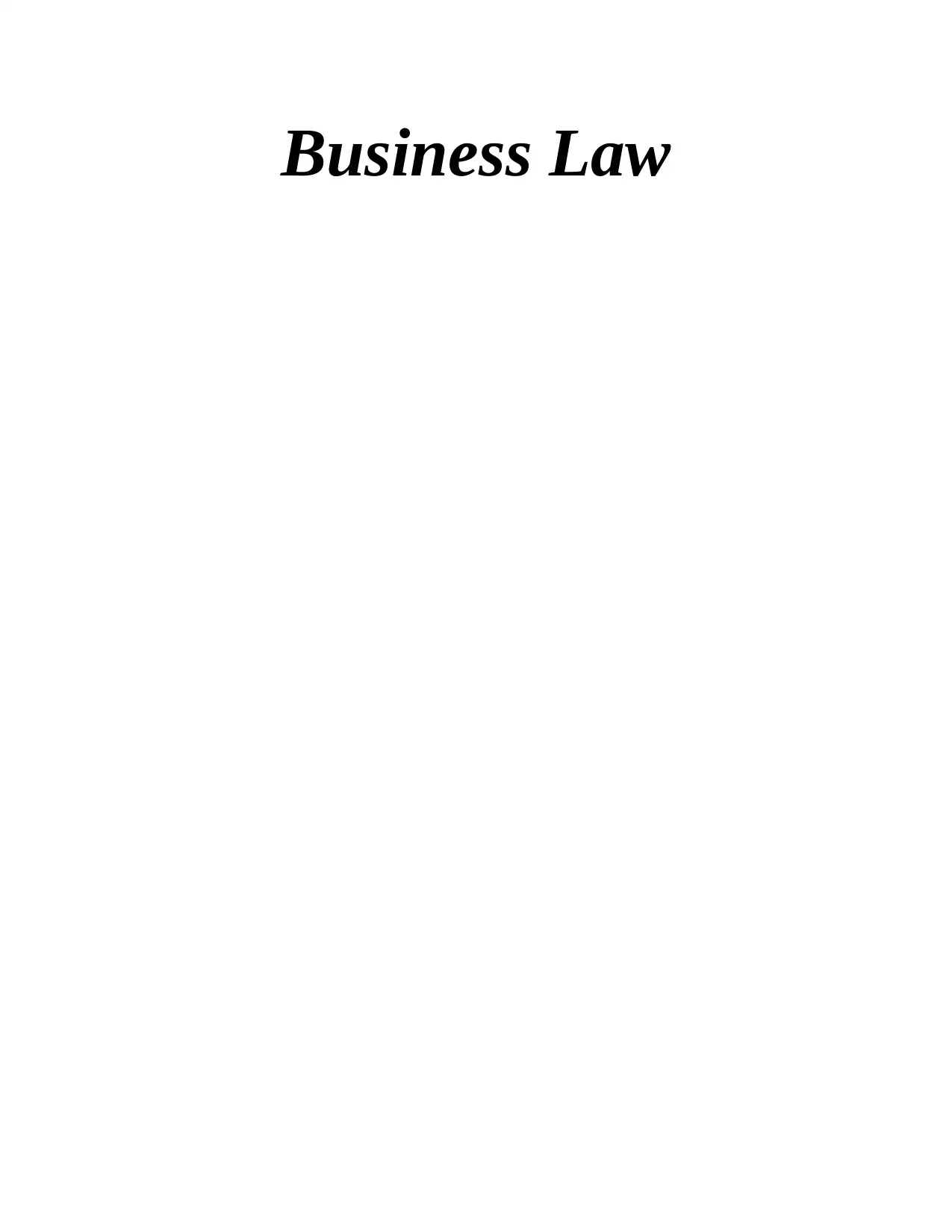
Business Law
Paraphrase This Document
Need a fresh take? Get an instant paraphrase of this document with our AI Paraphraser
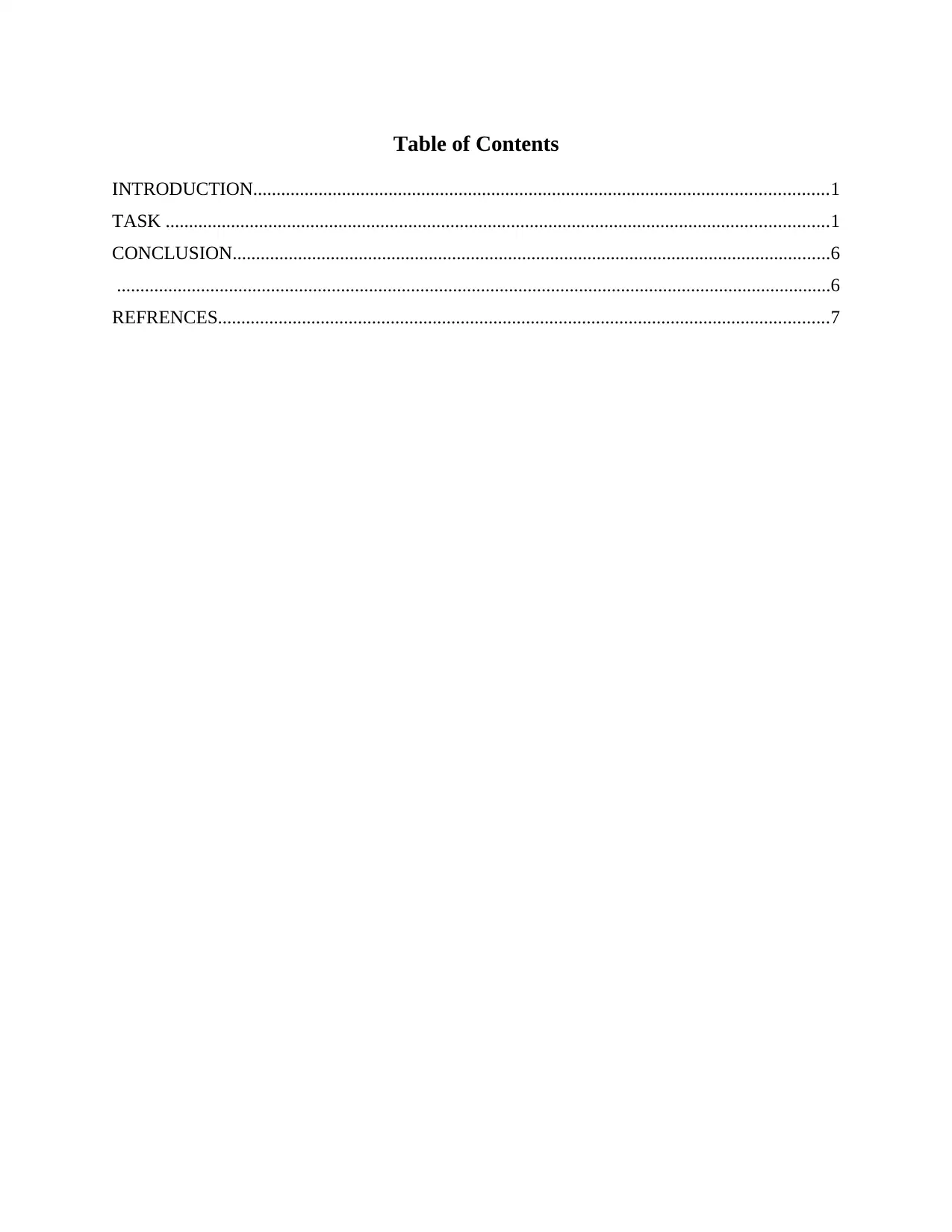
Table of Contents
INTRODUCTION...........................................................................................................................1
TASK ..............................................................................................................................................1
CONCLUSION................................................................................................................................6
.........................................................................................................................................................6
REFRENCES...................................................................................................................................7
INTRODUCTION...........................................................................................................................1
TASK ..............................................................................................................................................1
CONCLUSION................................................................................................................................6
.........................................................................................................................................................6
REFRENCES...................................................................................................................................7

INTRODUCTION
A deception of facts is always considered as a false argument which made re-presentee to
walk into the contract (Kubasek, Brennan. and Browne, 2016). In more simple terms it can be
stated that it allows individuals in recovering of pecuniary losses which forces in reliance on
untrue argument. But there are different types of solutions which are available for people who
have been an victim of injury caused by other people. Courts has a established doctrine which
provides remedies for financial issues that were left out in the contract law. In this report, tort of
negligence and misrepresentation of information are explained in brief and also supported by real
times cases.
TASK
Tort is a condition where an innocent party has been victimised and they are eligible to
claim for damages. The Australian law is based on the English common legislations which
makes it more important for individual to understand the core principle and rules in a proper
manner. Today, the tort is not considered to be similar as a criminal law (Schmit, 2014).
Basically, what differentiates Tort from criminal cases is that in this a person is suffering from
some issue which is there due to mistake of another individual. The person who committed the
mistake is is treated under Tort. The victim can basically seek out for claiming damages from the
other party under tort. The damaged party has all the rights to claim compensation for the
offence that was committed under tort. While if a person has committed murder, he will be
persecuted under the criminal law and his crimes will be punished.
Following are the components that are covered in the T.o.r.t. of Negligence:
Parties- These are the cases where there is a non contractual relationship between
different parties. In this the first party is doing his part of duty of caring and nursing another
party.
Intentions- There has to be pure intention from first party to care for another,this can be
understood by the fact that if there is cost involved which will be paid to the nursing individual
then he will provide good care.
Legal obligations- There is a contract between two parties which bound them to perform
certain task as per the stated guidelines. They have to complete all their job as per the
1
A deception of facts is always considered as a false argument which made re-presentee to
walk into the contract (Kubasek, Brennan. and Browne, 2016). In more simple terms it can be
stated that it allows individuals in recovering of pecuniary losses which forces in reliance on
untrue argument. But there are different types of solutions which are available for people who
have been an victim of injury caused by other people. Courts has a established doctrine which
provides remedies for financial issues that were left out in the contract law. In this report, tort of
negligence and misrepresentation of information are explained in brief and also supported by real
times cases.
TASK
Tort is a condition where an innocent party has been victimised and they are eligible to
claim for damages. The Australian law is based on the English common legislations which
makes it more important for individual to understand the core principle and rules in a proper
manner. Today, the tort is not considered to be similar as a criminal law (Schmit, 2014).
Basically, what differentiates Tort from criminal cases is that in this a person is suffering from
some issue which is there due to mistake of another individual. The person who committed the
mistake is is treated under Tort. The victim can basically seek out for claiming damages from the
other party under tort. The damaged party has all the rights to claim compensation for the
offence that was committed under tort. While if a person has committed murder, he will be
persecuted under the criminal law and his crimes will be punished.
Following are the components that are covered in the T.o.r.t. of Negligence:
Parties- These are the cases where there is a non contractual relationship between
different parties. In this the first party is doing his part of duty of caring and nursing another
party.
Intentions- There has to be pure intention from first party to care for another,this can be
understood by the fact that if there is cost involved which will be paid to the nursing individual
then he will provide good care.
Legal obligations- There is a contract between two parties which bound them to perform
certain task as per the stated guidelines. They have to complete all their job as per the
1
⊘ This is a preview!⊘
Do you want full access?
Subscribe today to unlock all pages.

Trusted by 1+ million students worldwide

requirement and in a appropriate manner. It is the responsibility of the party who has caused
damage to other individual to compensate him in a proper manner and ensure that he recovers.
Relevant Laws- There are two terms in the law books, Tort of negligence and Negligence
of Contract (Naffine, 2015). If there is a mistake made by a person which causes issue to other
individual then it will be dealt under the cited terms.
Apart from the above stated terms, there are 4 more ways that would assist in
understanding the legislations. They will also aid in proving that there is significant harm that
has been done:
Duty of Care- The result of negligence is completely dependent on the factor whether the
defendant ons any duty towards the petitioner. These obligations are there when the court
recognises the relationship between both parties and ensures that defendant fulfils all the
requirements as per requirement. It also ensures that defendant is not troubled from any undue
loss or harm.
Breach of Duty- The second party is liable if there is a breach of duty. Basically, it is
determined when defendant is not fulfilling all his duties in a proper manner (McKeehan. and
Rhodes, 2014). It is considered as a breach of contract as he is not providing care to other person
and also failing to meet the target.
Damages- In this part, the victim can ask fro compensation from the other party who
caused injury to him. But before they can claim, the petitioner has to prove the amount of
damages that were caused by the defendant in the house of law.
Remoteness- If the losses which are visible and recognised by court can be compensated
by the defendant. Basically, in this the offending party is liable for total loss even if it is more
than the expected amount. The claimant party can get additional support from the defendant if
there is requirement.
The Misrepresentation Act 1967, was enacted as to protect customers from different
fraudulent parties that put up false claims to make the victims form a contract. This legislation
allows the party in claiming total amount of damages if there is any (Macfarlane, Kahler. and
Conlin, 2017). Basically, if a seller states false facts about a product and it causes damages to the
customer then the consumer is entitled to ask for compensation. There are two types of remedies
which the victim can use in such scenarios:
2
damage to other individual to compensate him in a proper manner and ensure that he recovers.
Relevant Laws- There are two terms in the law books, Tort of negligence and Negligence
of Contract (Naffine, 2015). If there is a mistake made by a person which causes issue to other
individual then it will be dealt under the cited terms.
Apart from the above stated terms, there are 4 more ways that would assist in
understanding the legislations. They will also aid in proving that there is significant harm that
has been done:
Duty of Care- The result of negligence is completely dependent on the factor whether the
defendant ons any duty towards the petitioner. These obligations are there when the court
recognises the relationship between both parties and ensures that defendant fulfils all the
requirements as per requirement. It also ensures that defendant is not troubled from any undue
loss or harm.
Breach of Duty- The second party is liable if there is a breach of duty. Basically, it is
determined when defendant is not fulfilling all his duties in a proper manner (McKeehan. and
Rhodes, 2014). It is considered as a breach of contract as he is not providing care to other person
and also failing to meet the target.
Damages- In this part, the victim can ask fro compensation from the other party who
caused injury to him. But before they can claim, the petitioner has to prove the amount of
damages that were caused by the defendant in the house of law.
Remoteness- If the losses which are visible and recognised by court can be compensated
by the defendant. Basically, in this the offending party is liable for total loss even if it is more
than the expected amount. The claimant party can get additional support from the defendant if
there is requirement.
The Misrepresentation Act 1967, was enacted as to protect customers from different
fraudulent parties that put up false claims to make the victims form a contract. This legislation
allows the party in claiming total amount of damages if there is any (Macfarlane, Kahler. and
Conlin, 2017). Basically, if a seller states false facts about a product and it causes damages to the
customer then the consumer is entitled to ask for compensation. There are two types of remedies
which the victim can use in such scenarios:
2
Paraphrase This Document
Need a fresh take? Get an instant paraphrase of this document with our AI Paraphraser
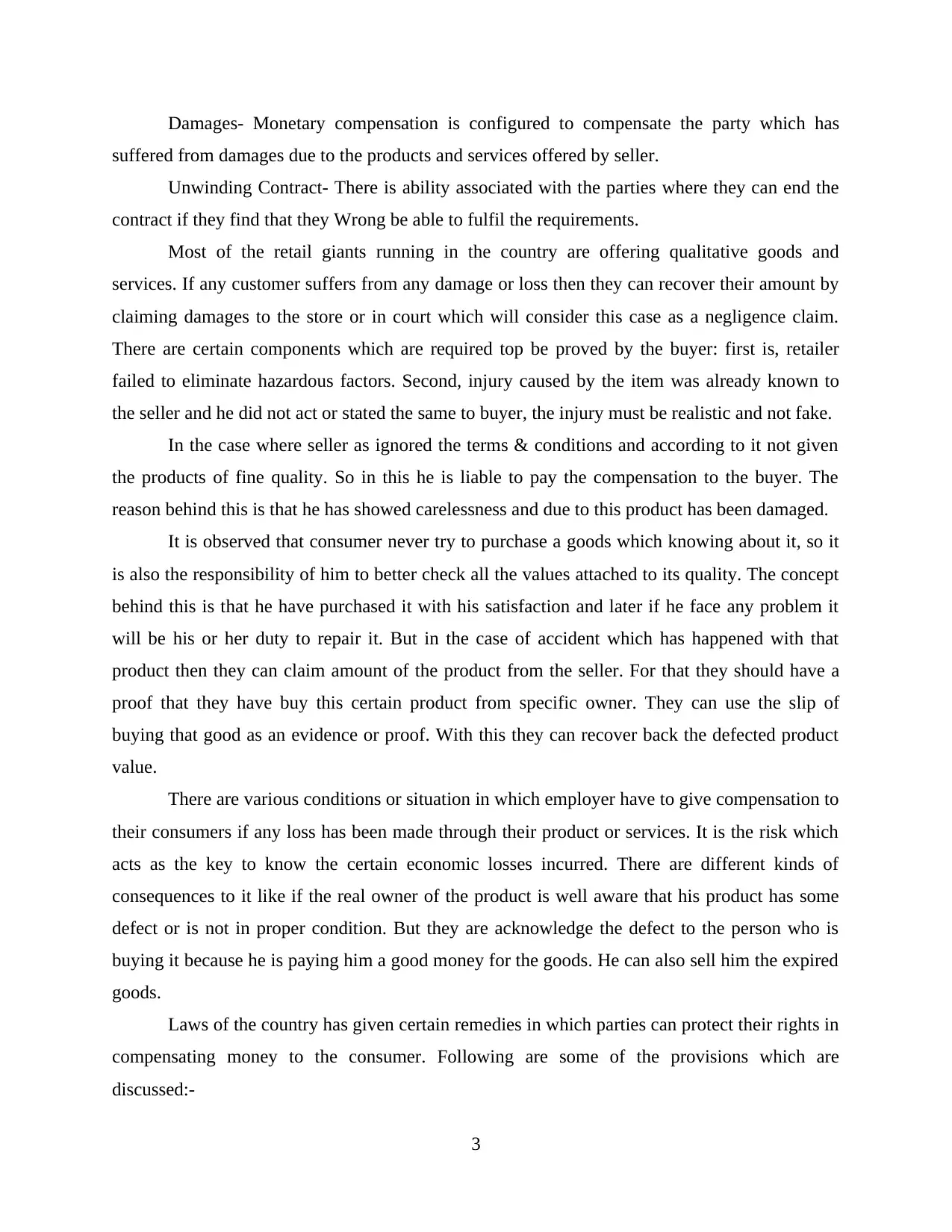
Damages- Monetary compensation is configured to compensate the party which has
suffered from damages due to the products and services offered by seller.
Unwinding Contract- There is ability associated with the parties where they can end the
contract if they find that they Wrong be able to fulfil the requirements.
Most of the retail giants running in the country are offering qualitative goods and
services. If any customer suffers from any damage or loss then they can recover their amount by
claiming damages to the store or in court which will consider this case as a negligence claim.
There are certain components which are required top be proved by the buyer: first is, retailer
failed to eliminate hazardous factors. Second, injury caused by the item was already known to
the seller and he did not act or stated the same to buyer, the injury must be realistic and not fake.
In the case where seller as ignored the terms & conditions and according to it not given
the products of fine quality. So in this he is liable to pay the compensation to the buyer. The
reason behind this is that he has showed carelessness and due to this product has been damaged.
It is observed that consumer never try to purchase a goods which knowing about it, so it
is also the responsibility of him to better check all the values attached to its quality. The concept
behind this is that he have purchased it with his satisfaction and later if he face any problem it
will be his or her duty to repair it. But in the case of accident which has happened with that
product then they can claim amount of the product from the seller. For that they should have a
proof that they have buy this certain product from specific owner. They can use the slip of
buying that good as an evidence or proof. With this they can recover back the defected product
value.
There are various conditions or situation in which employer have to give compensation to
their consumers if any loss has been made through their product or services. It is the risk which
acts as the key to know the certain economic losses incurred. There are different kinds of
consequences to it like if the real owner of the product is well aware that his product has some
defect or is not in proper condition. But they are acknowledge the defect to the person who is
buying it because he is paying him a good money for the goods. He can also sell him the expired
goods.
Laws of the country has given certain remedies in which parties can protect their rights in
compensating money to the consumer. Following are some of the provisions which are
discussed:-
3
suffered from damages due to the products and services offered by seller.
Unwinding Contract- There is ability associated with the parties where they can end the
contract if they find that they Wrong be able to fulfil the requirements.
Most of the retail giants running in the country are offering qualitative goods and
services. If any customer suffers from any damage or loss then they can recover their amount by
claiming damages to the store or in court which will consider this case as a negligence claim.
There are certain components which are required top be proved by the buyer: first is, retailer
failed to eliminate hazardous factors. Second, injury caused by the item was already known to
the seller and he did not act or stated the same to buyer, the injury must be realistic and not fake.
In the case where seller as ignored the terms & conditions and according to it not given
the products of fine quality. So in this he is liable to pay the compensation to the buyer. The
reason behind this is that he has showed carelessness and due to this product has been damaged.
It is observed that consumer never try to purchase a goods which knowing about it, so it
is also the responsibility of him to better check all the values attached to its quality. The concept
behind this is that he have purchased it with his satisfaction and later if he face any problem it
will be his or her duty to repair it. But in the case of accident which has happened with that
product then they can claim amount of the product from the seller. For that they should have a
proof that they have buy this certain product from specific owner. They can use the slip of
buying that good as an evidence or proof. With this they can recover back the defected product
value.
There are various conditions or situation in which employer have to give compensation to
their consumers if any loss has been made through their product or services. It is the risk which
acts as the key to know the certain economic losses incurred. There are different kinds of
consequences to it like if the real owner of the product is well aware that his product has some
defect or is not in proper condition. But they are acknowledge the defect to the person who is
buying it because he is paying him a good money for the goods. He can also sell him the expired
goods.
Laws of the country has given certain remedies in which parties can protect their rights in
compensating money to the consumer. Following are some of the provisions which are
discussed:-
3
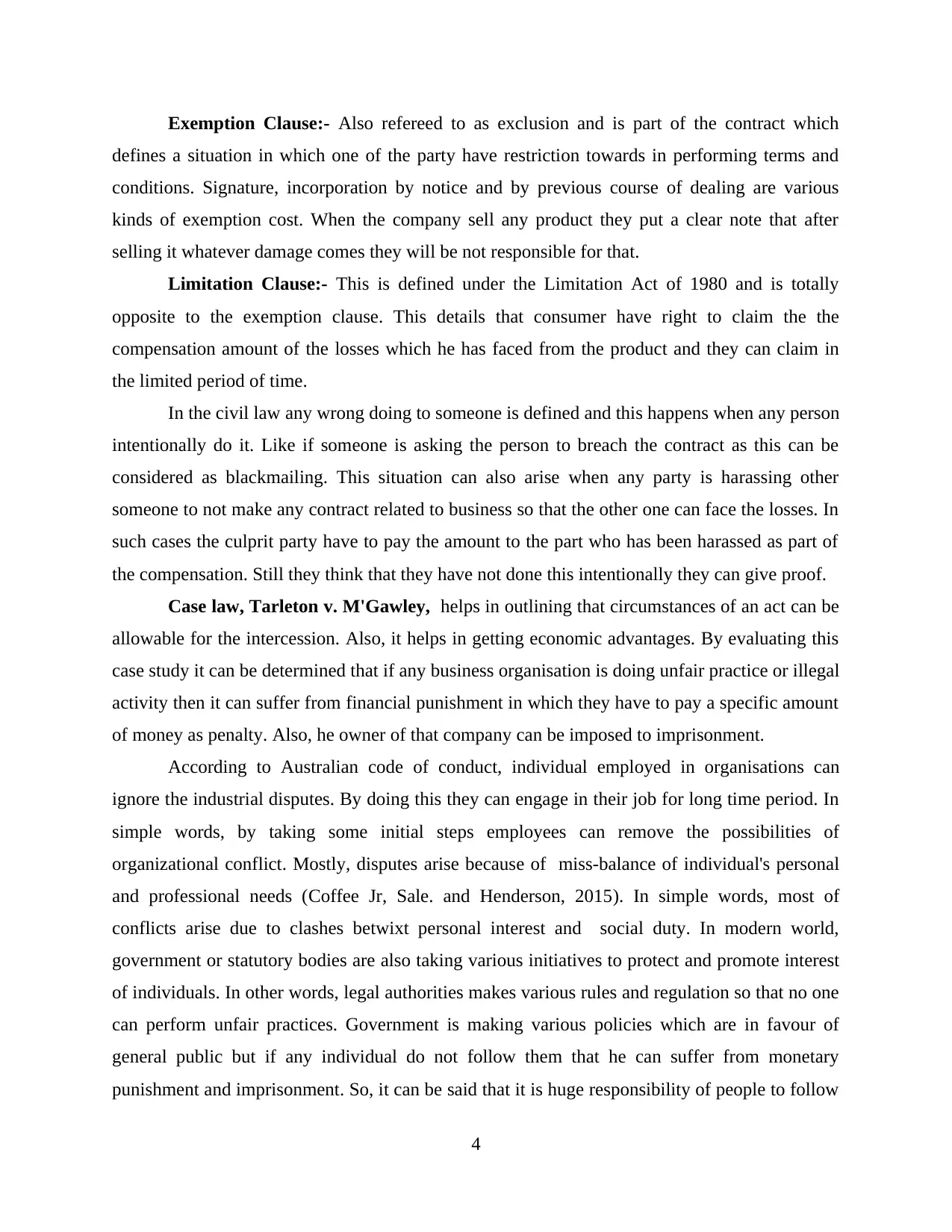
Exemption Clause:- Also refereed to as exclusion and is part of the contract which
defines a situation in which one of the party have restriction towards in performing terms and
conditions. Signature, incorporation by notice and by previous course of dealing are various
kinds of exemption cost. When the company sell any product they put a clear note that after
selling it whatever damage comes they will be not responsible for that.
Limitation Clause:- This is defined under the Limitation Act of 1980 and is totally
opposite to the exemption clause. This details that consumer have right to claim the the
compensation amount of the losses which he has faced from the product and they can claim in
the limited period of time.
In the civil law any wrong doing to someone is defined and this happens when any person
intentionally do it. Like if someone is asking the person to breach the contract as this can be
considered as blackmailing. This situation can also arise when any party is harassing other
someone to not make any contract related to business so that the other one can face the losses. In
such cases the culprit party have to pay the amount to the part who has been harassed as part of
the compensation. Still they think that they have not done this intentionally they can give proof.
Case law, Tarleton v. M'Gawley, helps in outlining that circumstances of an act can be
allowable for the intercession. Also, it helps in getting economic advantages. By evaluating this
case study it can be determined that if any business organisation is doing unfair practice or illegal
activity then it can suffer from financial punishment in which they have to pay a specific amount
of money as penalty. Also, he owner of that company can be imposed to imprisonment.
According to Australian code of conduct, individual employed in organisations can
ignore the industrial disputes. By doing this they can engage in their job for long time period. In
simple words, by taking some initial steps employees can remove the possibilities of
organizational conflict. Mostly, disputes arise because of miss-balance of individual's personal
and professional needs (Coffee Jr, Sale. and Henderson, 2015). In simple words, most of
conflicts arise due to clashes betwixt personal interest and social duty. In modern world,
government or statutory bodies are also taking various initiatives to protect and promote interest
of individuals. In other words, legal authorities makes various rules and regulation so that no one
can perform unfair practices. Government is making various policies which are in favour of
general public but if any individual do not follow them that he can suffer from monetary
punishment and imprisonment. So, it can be said that it is huge responsibility of people to follow
4
defines a situation in which one of the party have restriction towards in performing terms and
conditions. Signature, incorporation by notice and by previous course of dealing are various
kinds of exemption cost. When the company sell any product they put a clear note that after
selling it whatever damage comes they will be not responsible for that.
Limitation Clause:- This is defined under the Limitation Act of 1980 and is totally
opposite to the exemption clause. This details that consumer have right to claim the the
compensation amount of the losses which he has faced from the product and they can claim in
the limited period of time.
In the civil law any wrong doing to someone is defined and this happens when any person
intentionally do it. Like if someone is asking the person to breach the contract as this can be
considered as blackmailing. This situation can also arise when any party is harassing other
someone to not make any contract related to business so that the other one can face the losses. In
such cases the culprit party have to pay the amount to the part who has been harassed as part of
the compensation. Still they think that they have not done this intentionally they can give proof.
Case law, Tarleton v. M'Gawley, helps in outlining that circumstances of an act can be
allowable for the intercession. Also, it helps in getting economic advantages. By evaluating this
case study it can be determined that if any business organisation is doing unfair practice or illegal
activity then it can suffer from financial punishment in which they have to pay a specific amount
of money as penalty. Also, he owner of that company can be imposed to imprisonment.
According to Australian code of conduct, individual employed in organisations can
ignore the industrial disputes. By doing this they can engage in their job for long time period. In
simple words, by taking some initial steps employees can remove the possibilities of
organizational conflict. Mostly, disputes arise because of miss-balance of individual's personal
and professional needs (Coffee Jr, Sale. and Henderson, 2015). In simple words, most of
conflicts arise due to clashes betwixt personal interest and social duty. In modern world,
government or statutory bodies are also taking various initiatives to protect and promote interest
of individuals. In other words, legal authorities makes various rules and regulation so that no one
can perform unfair practices. Government is making various policies which are in favour of
general public but if any individual do not follow them that he can suffer from monetary
punishment and imprisonment. So, it can be said that it is huge responsibility of people to follow
4
⊘ This is a preview!⊘
Do you want full access?
Subscribe today to unlock all pages.

Trusted by 1+ million students worldwide
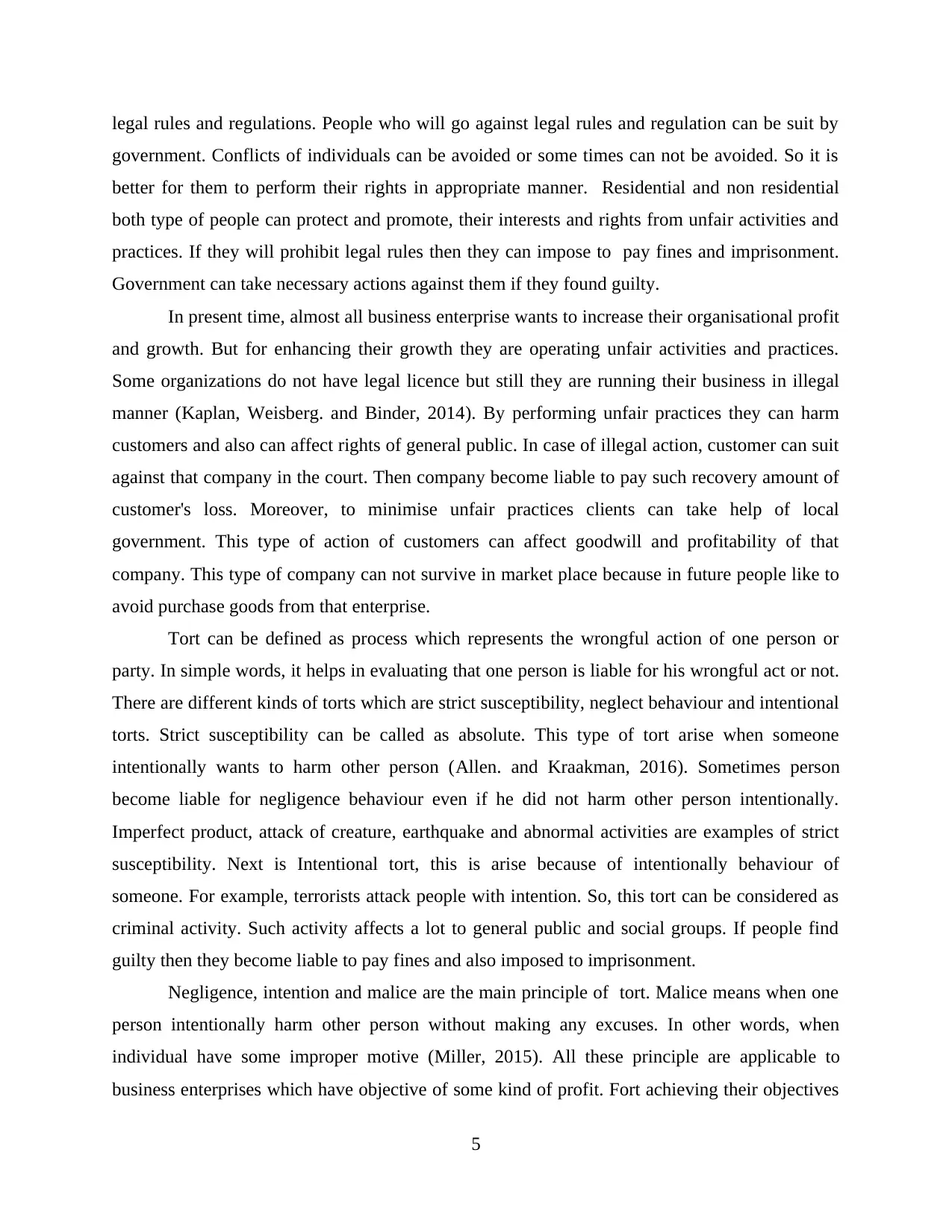
legal rules and regulations. People who will go against legal rules and regulation can be suit by
government. Conflicts of individuals can be avoided or some times can not be avoided. So it is
better for them to perform their rights in appropriate manner. Residential and non residential
both type of people can protect and promote, their interests and rights from unfair activities and
practices. If they will prohibit legal rules then they can impose to pay fines and imprisonment.
Government can take necessary actions against them if they found guilty.
In present time, almost all business enterprise wants to increase their organisational profit
and growth. But for enhancing their growth they are operating unfair activities and practices.
Some organizations do not have legal licence but still they are running their business in illegal
manner (Kaplan, Weisberg. and Binder, 2014). By performing unfair practices they can harm
customers and also can affect rights of general public. In case of illegal action, customer can suit
against that company in the court. Then company become liable to pay such recovery amount of
customer's loss. Moreover, to minimise unfair practices clients can take help of local
government. This type of action of customers can affect goodwill and profitability of that
company. This type of company can not survive in market place because in future people like to
avoid purchase goods from that enterprise.
Tort can be defined as process which represents the wrongful action of one person or
party. In simple words, it helps in evaluating that one person is liable for his wrongful act or not.
There are different kinds of torts which are strict susceptibility, neglect behaviour and intentional
torts. Strict susceptibility can be called as absolute. This type of tort arise when someone
intentionally wants to harm other person (Allen. and Kraakman, 2016). Sometimes person
become liable for negligence behaviour even if he did not harm other person intentionally.
Imperfect product, attack of creature, earthquake and abnormal activities are examples of strict
susceptibility. Next is Intentional tort, this is arise because of intentionally behaviour of
someone. For example, terrorists attack people with intention. So, this tort can be considered as
criminal activity. Such activity affects a lot to general public and social groups. If people find
guilty then they become liable to pay fines and also imposed to imprisonment.
Negligence, intention and malice are the main principle of tort. Malice means when one
person intentionally harm other person without making any excuses. In other words, when
individual have some improper motive (Miller, 2015). All these principle are applicable to
business enterprises which have objective of some kind of profit. Fort achieving their objectives
5
government. Conflicts of individuals can be avoided or some times can not be avoided. So it is
better for them to perform their rights in appropriate manner. Residential and non residential
both type of people can protect and promote, their interests and rights from unfair activities and
practices. If they will prohibit legal rules then they can impose to pay fines and imprisonment.
Government can take necessary actions against them if they found guilty.
In present time, almost all business enterprise wants to increase their organisational profit
and growth. But for enhancing their growth they are operating unfair activities and practices.
Some organizations do not have legal licence but still they are running their business in illegal
manner (Kaplan, Weisberg. and Binder, 2014). By performing unfair practices they can harm
customers and also can affect rights of general public. In case of illegal action, customer can suit
against that company in the court. Then company become liable to pay such recovery amount of
customer's loss. Moreover, to minimise unfair practices clients can take help of local
government. This type of action of customers can affect goodwill and profitability of that
company. This type of company can not survive in market place because in future people like to
avoid purchase goods from that enterprise.
Tort can be defined as process which represents the wrongful action of one person or
party. In simple words, it helps in evaluating that one person is liable for his wrongful act or not.
There are different kinds of torts which are strict susceptibility, neglect behaviour and intentional
torts. Strict susceptibility can be called as absolute. This type of tort arise when someone
intentionally wants to harm other person (Allen. and Kraakman, 2016). Sometimes person
become liable for negligence behaviour even if he did not harm other person intentionally.
Imperfect product, attack of creature, earthquake and abnormal activities are examples of strict
susceptibility. Next is Intentional tort, this is arise because of intentionally behaviour of
someone. For example, terrorists attack people with intention. So, this tort can be considered as
criminal activity. Such activity affects a lot to general public and social groups. If people find
guilty then they become liable to pay fines and also imposed to imprisonment.
Negligence, intention and malice are the main principle of tort. Malice means when one
person intentionally harm other person without making any excuses. In other words, when
individual have some improper motive (Miller, 2015). All these principle are applicable to
business enterprises which have objective of some kind of profit. Fort achieving their objectives
5
Paraphrase This Document
Need a fresh take? Get an instant paraphrase of this document with our AI Paraphraser
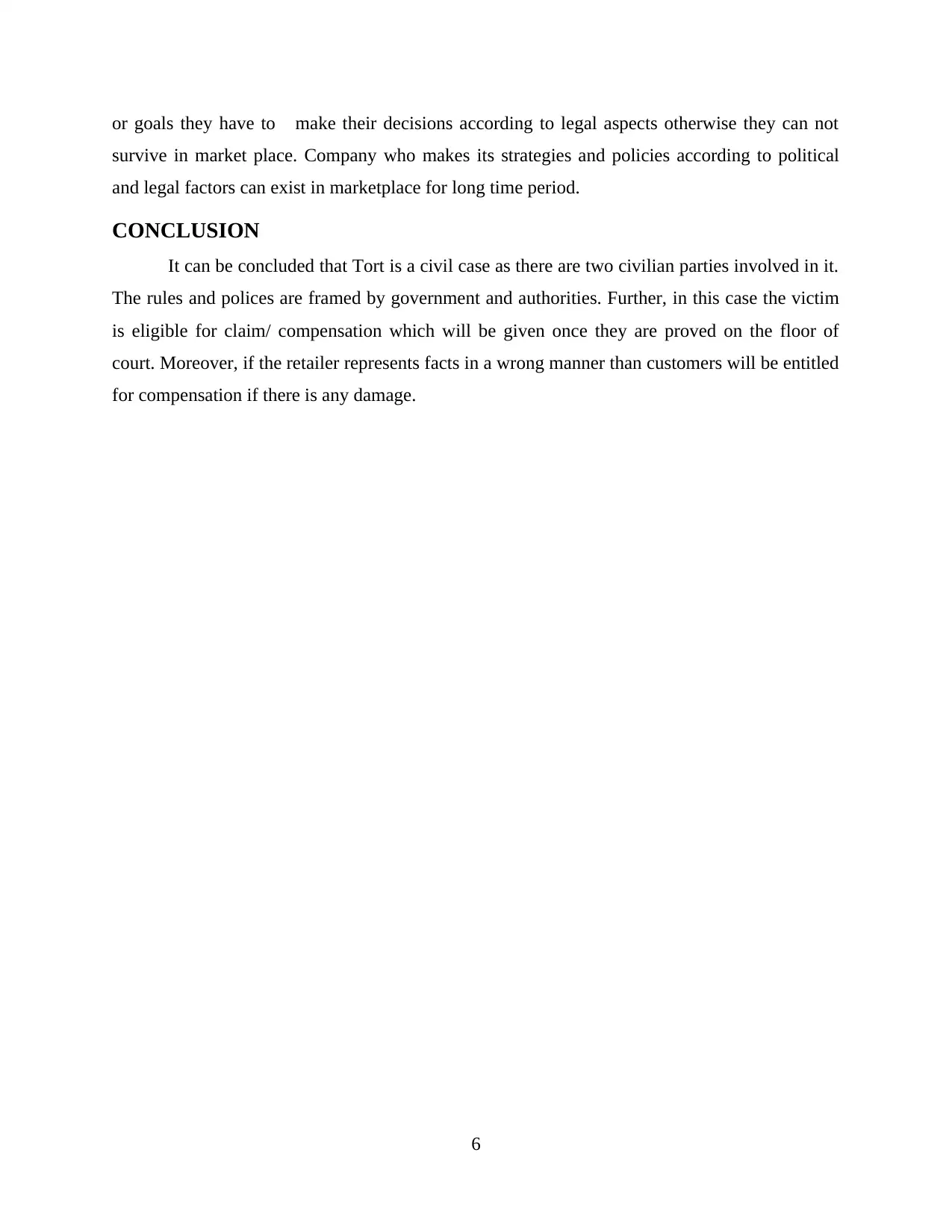
or goals they have to make their decisions according to legal aspects otherwise they can not
survive in market place. Company who makes its strategies and policies according to political
and legal factors can exist in marketplace for long time period.
CONCLUSION
It can be concluded that Tort is a civil case as there are two civilian parties involved in it.
The rules and polices are framed by government and authorities. Further, in this case the victim
is eligible for claim/ compensation which will be given once they are proved on the floor of
court. Moreover, if the retailer represents facts in a wrong manner than customers will be entitled
for compensation if there is any damage.
6
survive in market place. Company who makes its strategies and policies according to political
and legal factors can exist in marketplace for long time period.
CONCLUSION
It can be concluded that Tort is a civil case as there are two civilian parties involved in it.
The rules and polices are framed by government and authorities. Further, in this case the victim
is eligible for claim/ compensation which will be given once they are proved on the floor of
court. Moreover, if the retailer represents facts in a wrong manner than customers will be entitled
for compensation if there is any damage.
6
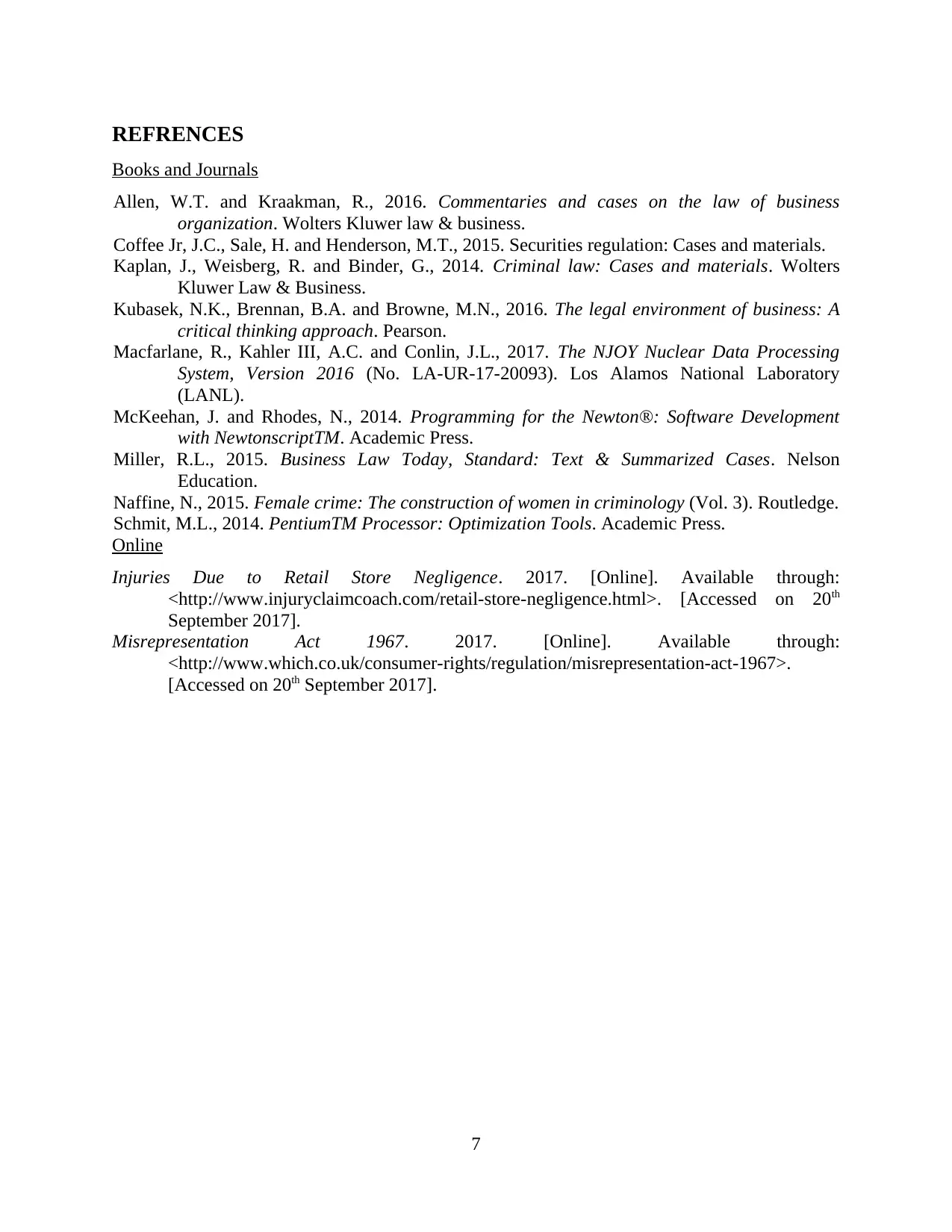
REFRENCES
Books and Journals
Allen, W.T. and Kraakman, R., 2016. Commentaries and cases on the law of business
organization. Wolters Kluwer law & business.
Coffee Jr, J.C., Sale, H. and Henderson, M.T., 2015. Securities regulation: Cases and materials.
Kaplan, J., Weisberg, R. and Binder, G., 2014. Criminal law: Cases and materials. Wolters
Kluwer Law & Business.
Kubasek, N.K., Brennan, B.A. and Browne, M.N., 2016. The legal environment of business: A
critical thinking approach. Pearson.
Macfarlane, R., Kahler III, A.C. and Conlin, J.L., 2017. The NJOY Nuclear Data Processing
System, Version 2016 (No. LA-UR-17-20093). Los Alamos National Laboratory
(LANL).
McKeehan, J. and Rhodes, N., 2014. Programming for the Newton®: Software Development
with NewtonscriptTM. Academic Press.
Miller, R.L., 2015. Business Law Today, Standard: Text & Summarized Cases. Nelson
Education.
Naffine, N., 2015. Female crime: The construction of women in criminology (Vol. 3). Routledge.
Schmit, M.L., 2014. PentiumTM Processor: Optimization Tools. Academic Press.
Online
Injuries Due to Retail Store Negligence. 2017. [Online]. Available through:
<http://www.injuryclaimcoach.com/retail-store-negligence.html>. [Accessed on 20th
September 2017].
Misrepresentation Act 1967. 2017. [Online]. Available through:
<http://www.which.co.uk/consumer-rights/regulation/misrepresentation-act-1967>.
[Accessed on 20th September 2017].
7
Books and Journals
Allen, W.T. and Kraakman, R., 2016. Commentaries and cases on the law of business
organization. Wolters Kluwer law & business.
Coffee Jr, J.C., Sale, H. and Henderson, M.T., 2015. Securities regulation: Cases and materials.
Kaplan, J., Weisberg, R. and Binder, G., 2014. Criminal law: Cases and materials. Wolters
Kluwer Law & Business.
Kubasek, N.K., Brennan, B.A. and Browne, M.N., 2016. The legal environment of business: A
critical thinking approach. Pearson.
Macfarlane, R., Kahler III, A.C. and Conlin, J.L., 2017. The NJOY Nuclear Data Processing
System, Version 2016 (No. LA-UR-17-20093). Los Alamos National Laboratory
(LANL).
McKeehan, J. and Rhodes, N., 2014. Programming for the Newton®: Software Development
with NewtonscriptTM. Academic Press.
Miller, R.L., 2015. Business Law Today, Standard: Text & Summarized Cases. Nelson
Education.
Naffine, N., 2015. Female crime: The construction of women in criminology (Vol. 3). Routledge.
Schmit, M.L., 2014. PentiumTM Processor: Optimization Tools. Academic Press.
Online
Injuries Due to Retail Store Negligence. 2017. [Online]. Available through:
<http://www.injuryclaimcoach.com/retail-store-negligence.html>. [Accessed on 20th
September 2017].
Misrepresentation Act 1967. 2017. [Online]. Available through:
<http://www.which.co.uk/consumer-rights/regulation/misrepresentation-act-1967>.
[Accessed on 20th September 2017].
7
⊘ This is a preview!⊘
Do you want full access?
Subscribe today to unlock all pages.

Trusted by 1+ million students worldwide
1 out of 9
Related Documents
Your All-in-One AI-Powered Toolkit for Academic Success.
+13062052269
info@desklib.com
Available 24*7 on WhatsApp / Email
![[object Object]](/_next/static/media/star-bottom.7253800d.svg)
Unlock your academic potential
Copyright © 2020–2025 A2Z Services. All Rights Reserved. Developed and managed by ZUCOL.





